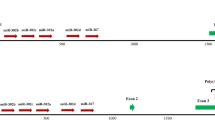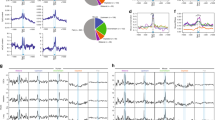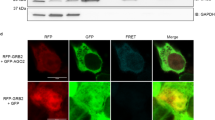Abstract
Prior work demonstrates that mammalian microRNA (miRNA or miR) expression requires RNA polymerase II (Pol II). However, the transcriptional requirements of many miRNAs remain untested. Our genomic analysis of miRNAs in the human chromosome 19 miRNA cluster (C19MC) revealed that they are interspersed among Alu repeats. Because Alu transcription occurs through RNA Pol III recruitment, and we found that Alu elements upstream of C19MC miRNAs retain sequences important for Pol III activity, we tested the promoter requirements of C19MC miRNAs. Chromatin immunoprecipitation and cell-free transcription assays showed that Pol III, but not Pol II, is associated with miRNA genomic sequence and sufficient for transcription. Moreover, the mature miRNA sequences of approximately 50 additional human miRNAs lie within Alu and other known repetitive elements. These findings extend the current view of miRNA origins and the transcriptional machinery driving their expression.
This is a preview of subscription content, access via your institution
Access options
Subscribe to this journal
Receive 12 print issues and online access
$189.00 per year
only $15.75 per issue
Buy this article
- Purchase on Springer Link
- Instant access to full article PDF
Prices may be subject to local taxes which are calculated during checkout




Similar content being viewed by others
References
Griffiths-Jones, S. et al. Rfam: annotating non-coding RNAs in complete genomes. Nucleic Acids Res. 33, D121–D124 (2005).
Zeng, Y., Wagner, E.J. & Cullen, B.R. Both natural and designed micro RNAs can inhibit the expression of cognate mRNAs when expressed in human cells. Mol. Cell 9, 1327–1333 (2002).
Lai, E.C. Micro RNAs are complementary to 3′ UTR sequence motifs that mediate negative post-transcriptional regulation. Nat. Genet. 30, 363–364 (2002).
Hutvagner, G. & Zamore, P.D. A microRNA in a multiple-turnover RNAi enzyme complex. Science 297, 2056–2060 (2002).
Yekta, S., Shih, I.H. & Bartel, D.P. MicroRNA-directed cleavage of HOXB8 mRNA. Science 304, 594–596 (2004).
Wu, L., Fan, J. & Belasco, J.G. MicroRNAs direct rapid deadenylation of mRNA. Proc. Natl. Acad. Sci. USA 103, 4034–4039 (2006).
Olsen, P.H. & Ambros, V. The lin-4 regulatory RNA controls developmental timing in Caenorhabditis elegans by blocking LIN-14 protein synthesis after the initiation of translation. Dev. Biol. 216, 671–680 (1999).
Lewis, B.P., Burge, C.B. & Bartel, D.P. Conserved seed pairing, often flanked by adenosines, indicates that thousands of human genes are microRNA targets. Cell 120, 15–20 (2005).
Cai, X., Hagedorn, C.H. & Cullen, B.R. Human microRNAs are processed from capped, polyadenylated transcripts that can also function as mRNAs. RNA 10, 1957–1966 (2004).
Lee, Y. et al. MicroRNA genes are transcribed by RNA polymerase II. EMBO J. 23, 4051–4060 (2004).
Smalheiser, N.R. EST analyses predict the existence of a population of chimeric microRNA precursor-mRNA transcripts expressed in normal human and mouse tissues. Genome Biol. 4, 403 (2003).
Smalheiser, N.R. & Torvik, V.I. Mammalian microRNAs derived from genomic repeats. Trends Genet. 21, 322–326 (2005).
Jurka, J. et al. Repbase Update, a database of eukaryotic repetitive elements. Cytogenet. Genome Res. 110, 462–467 (2005).
Bentwich, I. et al. Identification of hundreds of conserved and nonconserved human microRNAs. Nat. Genet. 37, 766–770 (2005).
Mighell, A.J., Markham, A.F. & Robinson, P.A. Alu sequences. FEBS Lett. 417, 1–5 (1997).
Harper, S.Q. & Davidson, B.L. Plasmid-based RNA interference: construction of small-hairpin RNA expression vectors. Methods Mol. Biol. 309, 219–235 (2005).
Jurka, J. Evolutionary impact of human Alu repetitive elements. Curr. Opin. Genet. Dev. 14, 603–608 (2004).
Allen, T.A., Von Kaenel, S., Goodrich, J.A. & Kugel, J.F. The SINE-encoded mouse B2 RNA represses mRNA transcription in response to heat shock. Nat. Struct. Mol. Biol. 11, 816–821 (2004).
Espinoza, C.A., Allen, T.A., Hieb, A.R., Kugel, J.F. & Goodrich, J.A. B2 RNA binds directly to RNA polymerase II to repress transcript synthesis. Nat. Struct. Mol. Biol. 11, 822–829 (2004).
Wang, Z., Luo, T. & Roeder, R.G. Identification of an autonomously initiating RNA polymerase III holoenzyme containing a novel factor that is selectively inactivated during protein synthesis inhibition. Genes Dev. 11, 2371–2382 (1997).
Pfeffer, S. et al. Identification of microRNAs of the herpesvirus family. Nat. Methods 2, 269–276 (2005).
Shankar, R., Grover, D., Brahmachari, S.K. & Mukerji, M. Evolution and distribution of RNA polymerase II regulatory sites from RNA polymerase III dependant mobile Alu elements. BMC Evol. Biol. 4, 37 (2004).
Liu, W.M., Chu, W.M., Choudary, P.V. & Schmid, C.W. Cell stress and translational inhibitors transiently increase the abundance of mammalian SINE transcripts. Nucleic Acids Res. 23, 1758–1765 (1995).
Chesnokov, I. & Schmid, C.W. Flanking sequences of an Alu source stimulate transcription in vitro by interacting with sequence-specific transcription factors. J. Mol. Evol. 42, 30–36 (1996).
Yang, N. L1 retrotransposition is suppressed by endogenously encoded small interfering RNAs in human cultured cells. Nat. Struct. Mol. Biol. 13, 763–771 (2006).
Acknowledgements
The authors are grateful to Robert Roeder at Rockefeller University for antibodies to Pol III, TFIIIB and TFIIIC subunits, for the BN51 cell line and for suggestions for the ChIP studies. We also thank S. Harper, R. Boudreau, C. Stein and S. Eliason for assistance and discussions, M. Welsh, R. Cornell and P. McCray for manuscript review and C. McLennan for manuscript assistance. This work was supported by the US National Institutes of Health (HD 44093; NS 50210) and the Roy J. Carver Trust.
Author information
Authors and Affiliations
Contributions
G.M.B. conceived the study, collected the experimental data and contributed to the identification of repetitive element–microRNA associations, design and planning of the wet-lab experimentation, analysis of the experimental and computational findings and writing of the manuscript. W.L. contributed to the identification of repetitive element–microRNA associations and computational analysis. B.L.D. contributed to design and planning of the wet-lab experimentation, analysis of the experimental and computational findings and writing of the manuscript. All authors edited and approved the final version of the manuscript.
Corresponding author
Ethics declarations
Competing interests
The authors declare no competing financial interests.
Supplementary information
Supplementary Fig. 1
Pol-III subunits and antibody specificity. (PDF 680 kb)
Supplementary Table 1
Human miRNA repetitive element alignments. (PDF 7577 kb)
Supplementary Table 2
C19MC ESTs. (PDF 522 kb)
Supplementary Table 3
Additional human Pol III–driven miRNAs. (PDF 1023 kb)
Supplementary Table 4
C19MC negative strand Pol III terminators. (PDF 4425 kb)
Supplementary Table 5
Oligonucleotide masterlist. (PDF 2181 kb)
Rights and permissions
About this article
Cite this article
Borchert, G., Lanier, W. & Davidson, B. RNA polymerase III transcribes human microRNAs. Nat Struct Mol Biol 13, 1097–1101 (2006). https://doi.org/10.1038/nsmb1167
Received:
Accepted:
Published:
Issue Date:
DOI: https://doi.org/10.1038/nsmb1167
This article is cited by
-
MicroRNAs and Cardiovascular Disease Risk
Current Cardiology Reports (2024)
-
The various role of microRNAs in breast cancer angiogenesis, with a special focus on novel miRNA-based delivery strategies
Cancer Cell International (2023)
-
The Role of MicroRNA in the Myocarditis: a Small Actor for a Great Role
Current Cardiology Reports (2023)
-
MicroRNAs in the pathophysiology of Alzheimer’s disease and Parkinson's disease: an overview
Molecular Neurobiology (2022)
-
High expression level of miR-1260 family in the peripheral blood of patients with ovarian carcinoma
Journal of Ovarian Research (2021)



